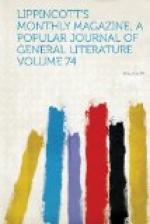Philip A. Bruce.
SCENES OF CHARLOTTE BRONTE’S LIFE IN BRUSSELS.
We had “done” Brussels after the approved fashion,—had faithfully visited the churches, palaces, museums, theatres, galleries, monuments, and boulevards, had duly admired the beautiful windows and the exquisite wood-carvings of the grand old cathedral of St. Gudule, the tower and tapestry and frescos and facade of the magnificent Hotel-de-Ville, the stately halls and the gilded dome of the immense new Courts of Justice, and the consummate beauty of the Bourse, had diligently sought out the naive boy-fountain, and had made the usual excursion to Waterloo.
This delightful task being conscientiously discharged, we proposed to devote our last day in the beautiful Belgian capital to the accomplishment of one of the cherished projects of our lives,—the searching out of the localities associated with Charlotte Bronte’s unhappy school-life here, which she has so graphically portrayed. For our purpose no guide was available, or needful, for the topography and local coloring of “Villette” and “The Professor” are as vivid and unmistakable as in the best work of Dickens himself. Proceeding from St. Gudule, by the little street at the back of the cathedral, to the Rue Royale, and a short distance along that grand thoroughfare, we reached the park and a locality familiar to Miss Bronte’s readers. Seated in this lovely pleasure-ground, the gift of the empress Maria Theresa, with its cool shade all about us, we noted the long avenues and the paths winding amid stalwart trees and verdant shrubbery, the dark foliage ineffectually veiling the gleaming statuary and the sheen of bright fountains, “the stone basin with its clear depth, the thick-planted trees which framed this tremulous and rippled mirror,” the groups of happy people filling the seats in secluded nooks or loitering in the cool mazes and listening to the music,—we noted all this, and felt that Miss Bronte had revealed it to us long ago. It was across this park that Lucy Snowe was piloted from the bureau of the diligence by the chivalrous stranger, Dr. John, on the night when she, despoiled, helpless, and solitary, arrived in Brussels. She found the park deserted and dark, the paths miry, the water “dripping from its trees.” “In the double gloom of tree and fog she could not see her guide, and could only follow his tread”




